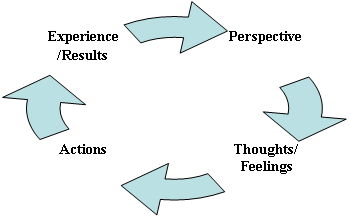In Cultivating Strength (see http://www.creativeleadercoach.com/2008/10/10/cultivating-strength/ ), we discussed how speaking our truth and postive thoughts and words literally make us stronger. In this post, we will talk a bit about a way of understanding the world, so that we can more easily see why this might be true.
The science of psychoneuroimmunology, which studies the intimate relationship of our minds and bodies, shows us that our subjective states have physical correlates. And other posts in this blog have discussed how our perspectives, thoughts and feelings help shape our social, and ultimately environmental realities, in both gross and subtle ways.
This is common sense: We know, for example, that stress can physically damage our bodies, and we usually easily notice when a person is joyful, anxious, loving, or angry. And, of course, our actions arise from the complex interrelationships of our thoughts and feelings.
Yet, culturally, we are generally taught (when we are taught such things), that mind and body are two entirely different spheres. In philosophical terms, this is called mind-body dualism. However, another, altogether different view has arisen from both our common sense experience and new sciences, such as psychoneuroimmunology. The psycho-social or process view observes that subjective and objective states might be thought of as two sides of the same coin. For this reason, the term “body-mind” is increasingly frequently used to refer to ourselves as unified beings, having both subjective and objective dimensions.
Cultivating Strength described how negative thoughts and feelings can weaken us. We know that unmanaged stress can have negative consequences for our physical, mental, emotional, social, financial .. health, and depending on our actions, for the health of the environment. Thankfully! conversely, postive thoughts and emotions can be healing. (For example, see professor Norman Cousins’ Anatomy of an Illness).
Our perspectives, which guide our perceptions, and hence thoughts and emotions are extraordinarily powerful with respect to the physical, social and environmental realities that we co-create. Yet, because our perspectives, or the way we view things, tend to be implicit — both in a physical and psychological sense prior to our actual thoughts — we are often not consciously aware of them and how they are creating our circumstances.
Therefore, it’s useful to exhume?! our perspectives to better understand how they are shaping our lives, and to decide whether we want to keep them as is, or whether other perspectives might help us create the kinds of lives (and organizations) we want.
To be continued!

